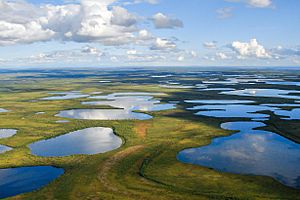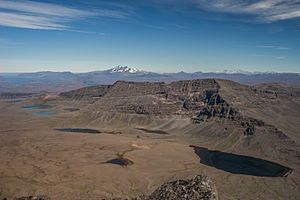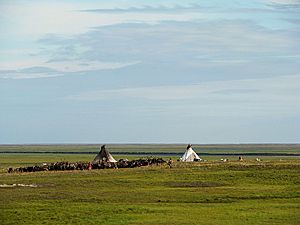Tundra facts for kids
Quick facts for kids Tundra |
|
|---|---|
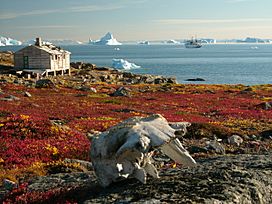
Tundra in Greenland
|
|

Map showing Arctic tundra
|
|
| Geography | |
| Area | 11,563,300 km2 (4,464,600 sq mi) |
| Climate type | ET |
Imagine a place where trees can't grow because it's too cold! That's a tundra. It's a special type of biome (a large natural area) where the ground is often frozen. The word "tundra" comes from a Russian word, which itself came from a Sámi word meaning "treeless mountain tract" or "uplands."
Tundra areas have very cold temperatures and short growing seasons. The plants that live here are usually small. You'll find dwarf shrubs, sedges, grasses, mosses, and lichens. Sometimes, a few scattered trees can grow in certain tundra regions.
The edge where the tundra meets the forest is called the tree line. Tundra soil is full of important nutrients like nitrogen and phosphorus. It also holds a lot of old plant material, which stores gases like methane and carbon dioxide in the permafrost (permanently frozen ground). This makes the tundra soil a "carbon sink," meaning it stores carbon.
However, as the Earth gets warmer, the permafrost can melt. When this happens, these stored gases are released into the air. This can speed up climate change, which is a big concern for the tundra.
Contents
Exploring the Arctic Tundra
The Arctic tundra is found in the far Northern Hemisphere. It's located north of the taiga (the vast forest belt). When people say "tundra," they usually mean these areas where the ground is always frozen, called permafrost.
Vast areas of northern Russia and Canada are covered by permafrost tundra. Many people, like the Nganasan and Nenets, live here. They often move around with their reindeer herds.

Arctic Tundra Landscape
The Arctic tundra looks quite stark and is frozen for most of the year. The soil is frozen deep down, making it impossible for tall trees to grow. Instead, you'll see bare or rocky land with low-growing plants. These include moss, heath (like crowberry and black bearberry), and lichen.
Seasons in the Arctic
The polar tundra has two main seasons: winter and summer. Winters are very cold, dark, and windy. The average temperature is around -28°C (-18°F), and it can drop to -50°C (-58°F). Even so, the coldest temperatures in the tundra are not as extreme as those in the taiga forests further south.
During the summer, temperatures go up a bit. The top layer of the frozen soil melts, making the ground very wet and soggy. The tundra becomes covered with marshes, lakes, bogs, and streams in the warmer months. Summer daytime temperatures usually reach about 12°C (54°F) but can often fall to 3°C (37°F) or even below freezing.
Wind and Water in the Tundra
Tundra areas are often very windy, with winds blowing over 50 to 100 kilometers per hour (30 to 60 mph). Despite the wet ground in summer, the tundra is actually like a desert when it comes to rainfall. It only gets about 150 to 250 millimeters (6 to 10 inches) of precipitation each year. Most of this falls in the summer.
Even though there isn't much rain or snow, the water doesn't evaporate quickly. In summer, the permafrost thaws just enough for plants to grow. But since the ground below is still frozen, the water can't drain away. This is why lakes and marshes form.
Wildfires can happen in the tundra, especially in drier areas. In Alaska, fires typically occur every 150 to 200 years.
Animals of the Arctic Tundra
The Arctic tundra doesn't have a huge variety of plants and animals. There are about 1,700 types of plants and only 48 kinds of land mammals. However, millions of birds fly there every year to use the marshes. You can also find a few types of fish.
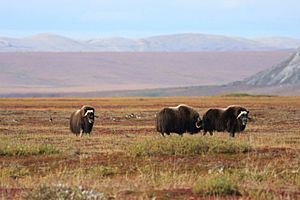
Some well-known animals in the Arctic tundra include reindeer (also called caribou), musk ox, Arctic hare, Arctic fox, snowy owl, ptarmigan, northern red-backed voles, lemmings, and even polar bears near the ocean. You won't find many cold-blooded animals like frogs or lizards here.
Human Impact and Resources
Because of the harsh climate, not many people have lived in the Arctic tundra for a long time. However, these areas are sometimes rich in natural resources like petroleum (oil), natural gas, and uranium. This is starting to change in places like Alaska and Russia. For example, one region in Russia, the Yamalo-Nenets Autonomous Okrug, produces 90% of Russia's natural gas.
Tundra and Climate Change
A major threat to the tundra is global warming. This causes the permafrost to melt. If the permafrost melts over decades or centuries, it could completely change which plants and animals can survive there.
Another big worry is that about one-third of the world's carbon stored in soil is found in taiga and tundra areas. When the permafrost melts, it releases carbon as carbon dioxide and methane. Both of these are greenhouse gases that trap heat in the atmosphere.
Scientists have seen this happening in Alaska. In the 1970s, the tundra was absorbing carbon (a "carbon sink"). But today, it's releasing carbon (a "carbon source"). Methane is also produced when dead plants decay in lakes and wetlands.
The exact amount of greenhouse gases that will be released as the world warms is still being studied. Also, when dead plants and peat (partially decayed plant matter) build up, there's a risk of wildfires. In 2007, a huge area of tundra (1,039 square kilometers or 401 square miles) burned in Alaska. These fires can both be caused by and contribute to global warming.
Antarctic Tundra
The Antarctic tundra is found on Antarctica and on several islands near it. These include South Georgia and the South Sandwich Islands and the Kerguelen Islands. Most of Antarctica is too cold and dry for plants, as it's covered by ice.
However, some parts of the continent, especially the Antarctic Peninsula, have rocky soil that supports plant life. The plants here include about 300 to 400 types of lichens, 100 mosses, 25 liverworts, and around 700 types of algae. These grow on the exposed rocks and soil near the coast. Antarctica has only two types of flowering plants: the Antarctic hair grass and Antarctic pearlwort. They are found in the northern and western parts of the Antarctic Peninsula.
Unlike the Arctic tundra, the Antarctic tundra doesn't have many large land mammals. This is mainly because it's so isolated from other continents. Sea mammals and birds, like seals and penguins, live near the shore. Some small mammals, like rabbits and cats, have been brought to a few subantarctic islands by humans.
The plants and animals of Antarctica and its islands are protected by the Antarctic Treaty. This treaty helps keep these unique environments safe.
Alpine Tundra
Alpine tundra is found in mountains all over the world. It doesn't have trees because the climate and soil at high altitudes prevent them from growing. The cold climate in alpine tundra is similar to polar climates, with low air temperatures.
Alpine tundra is different from Arctic tundra in a few ways. Alpine tundra usually doesn't have permafrost. Also, alpine soils tend to drain water better than Arctic soils. Below the alpine tundra, you'll find subalpine forests. The stunted, twisted trees at the edge of the treeline are called Krummholz.
Alpine Tundra Plants
The plants in alpine tundra grow close to the ground. They include perennial grasses, sedges, forbs (flowering plants), cushion plants, mosses, and lichens. These plants are specially adapted to the tough conditions of the mountains. They can handle low temperatures, dryness, strong ultraviolet radiation, and a very short growing season.
Tundra Climates Around the World
Tundra climates are usually classified as ET in the Köppen climate system. This means that at least one month has an average temperature warm enough to melt snow (above 0°C or 32°F). However, no month has an average temperature above 10°C (50°F).
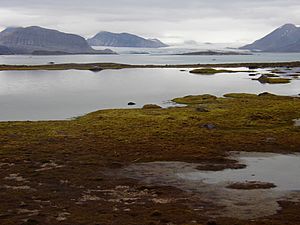
The coldest limit of tundra climates meets areas of permanent ice and snow. The warmer limit usually matches where trees stop growing, leading into subarctic climates. Even where winters are milder, tundra climates are generally too harsh for woody plants to grow.
Even though there can be different amounts of rain and snow, and different extreme temperatures, tundra climates are rarely divided into smaller categories. Rainfall and snowfall are usually light because the cold air holds less water vapor. However, because water doesn't evaporate much, the ground can still be soggy. You might find swamps and bogs even in places that get as little rain as deserts in other parts of the world. The amount of plant life in the tundra depends more on the local temperature than on how much precipitation it gets.
For example, the city of Ushuaia in Argentina has an ET climate. Its warmest month (January) has an average temperature of 9.7°C (49.5°F). But it has no months with an average temperature below freezing. Its coldest month (June) averages 1.7°C (35.1°F).
Places with Tundra Climates
Alpine Tundra Locations
- Mount Fuji, Japan
- Cerro de Pasco, Peru
- Apartaderos, Venezuela
- Puno, Peru
Polar Tundra Locations
- Longyearbyen, Svalbard, Norway
- Honningsvåg, Troms og Finnmark, Norway
- Iqaluit, Canada
- Utqiagvik, United States
- Kerguelen Islands, French Southern Lands (France)
- Nuuk, Greenland (Denmark)
- Grytviken, South Georgia (United Kingdom)
- Tiksi, Russia
- Kasprowy Wierch, Poland
- High Tatras, Slovakia
- Murghob, Tajikistan
- Mount Wellington, Australia
- Mykines, Faroe Islands (Denmark)
- Putre, Chile
- Coranzuli, Argentina
- Campbell Island, New Zealand
- Cairn Gorm, United Kingdom
- Yu Shan, Taiwan
See also
 In Spanish: Tundra para niños
In Spanish: Tundra para niños


